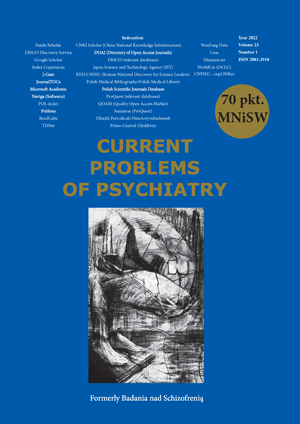Schizo-obsessive disorder - case study
DOI:
https://doi.org/10.2478/cpp-2022-0004Keywords:
schizophrenia, schizo-obsessive disorder, OCD, OCSAbstract
Introduction. Schizo-obsessive disorder is a term that includes a dual diagnosis: schizophrenia and obsessive-compulsive disorder (OCD). The schizo-obsessive disorder definition was made at the end of the 19th century and is still valid today. Nowadays, the coexistence of schizophrenia with obsessive-compulsive syndromes becomes more commonly observed, therefore the recognition and number of the described cases has increased.
Material and methods. The aim of this article is to present a clinical case of a patient with a diagnostically and therapeutically difficult disorder, including the comorbidity of schizophrenia and OCD. The analysis of the clinical case and the medical records of a patient and a review of the literature including schizophrenia, OCD, and schizo-obsessive disorder, was performed.
Case study. A male patient, 20 years old, single, high school student, who lives with his family. In November 2019 a mental deterioration occurred. Simultaneously, obsessional ideas and behaviors appeared. An ambulatory treatment was introduced, however without adequate response, which was the cause of the first psychiatric hospitalization in 2020.
Discussion. Comorbidity between obsessive-compulsive disorder and schizophrenia may cause a particular problem for physicians. Without appropriate diagnosis, there is no possibility to implement proper management and treatment. Obsessivecompulsive symptoms should be treated as relatively common in patients with schizophrenia, which will prevent a mistake in the assessment of the patient's condition.
Conclusions. Due to specific character of the disease, difficulties in diagnosis and treatment, there is a special need for individual therapeutic measures. Appropriate and targeted approach to the patient may be a chance for success in therapy.
References
1. Patel DD, Laws KR, Padhi A, et al. The neuropsychology of the schizo-obsessive subtype of schizophrenia: a new analysis. Psychol Med. 2010;40(6):921-933.
2. Berrios G. E. Obsessive-compulsive disorder: Its conceptual history in France during the 19th century. Comprehensive Psychiatry, 30(4), 283–295.
3. Tezenas du Montcel C, Pelissolo A, Schürhoff F, Pignon B. Obsessive-Compulsive Symptoms in Schizophrenia: an Up-To-Date Review of Literature. Curr Psychiatry Rep., 2019; 21(8):64.
4. Frías Á, Palma C, Farriols N, Becerra C, Álvarez A, Cañete J. Neuropsychological profile and treatment-related features among patients with comorbidity between schizophrenia spectrum disorder and obsessive–compulsive disorder: is there evidence for a “schizo-obsessive” subtype?. Psychiatry Res. 2014;220(3):846-854.
5. Murphy DL, Timpano KR, Wheaton MG, Greenberg BD, Miguel EC. Obsessive-compulsive disorder and its related disorders: a reappraisal of obsessive-compulsive spectrum concepts. Dialogues Clin Neurosci. 2010;12(2):131-148.
6. de Haan L, Dudek-Hodge C, Verhoeven Y, Denys D. Prevalence of psychotic disorders in patients with obsessive-compulsive disorder. CNS Spectr. 2009;14(8):415-417.
7. Cederlöf M, Lichtenstein P, Larsson H, et al. Obsessive-Compulsive Disorder, Psychosis, and Bipolarity: A Longitudinal Cohort and Multigenerational Family Study. Schizophr Bull. 2015;41(5):1076-1083.
8. Meier SM, Petersen L, Pedersen MG, et al. Obsessive-compulsive disorder as a risk factor for schizophrenia: a nationwide study. JAMA Psychiatry. 2014;71(11):1215-1221.
9. Kang DH, Kim SH, Kim CW, et al. Thalamus surface shape deformity in obsessive-compulsive disorder and schizophrenia. Neuroreport. 2008;19(6):609-613.
10. Kwon JS, Shin YW, Kim CW, et al. Similarity and disparity of obsessive-compulsive disorder and schizophrenia in MR volumetric abnormalities of the hippocampus-amygdala complex. J Neurol Neurosurg Psychiatry. 2003;74(7):962-964.
11. Adamowski T., Ledzińska S., Kiejna A. Spektrum zaburzeń obsesyjno-kompulsyjnych – nowa kategoria diagnostyczna?, Adv Clin Exp Med, 2005; 14(2): 369-373.
12. Tibbo P, Kroetsch M, Chue P, Warneke L. Obsessive-compulsive disorder in schizophrenia. J Psychiatr Res. 2000;34(2):139-146.
13. Sevincok L, Akoglu A, Topaloglu B, Arslantas H. Neurological soft signs in schizophrenic patients with obsessive-compulsive disorder. Psychiatry Clin Neurosci. 2004;58(3):274-279.
14. Żerdziński M., Pląder A. Zaburzenia obsesyjnokompulsyjne i schizofrenia: różnicowanie, współwystępowanie, leczenie. Postępy Psychiatrii i Neurologii 2004; 13 (3): 263-276.
Downloads
Published
Issue
Section
License
Copyright (c) 2022 Authors

This work is licensed under a Creative Commons Attribution 4.0 International License.


